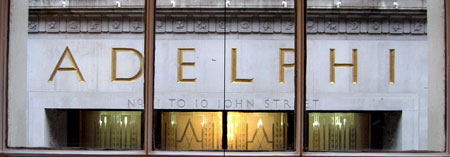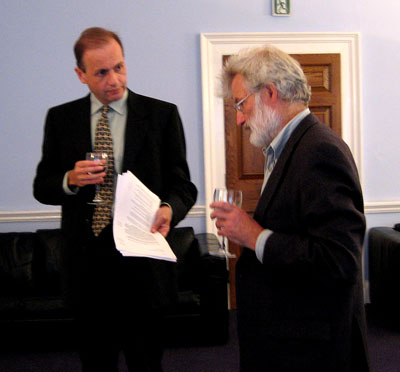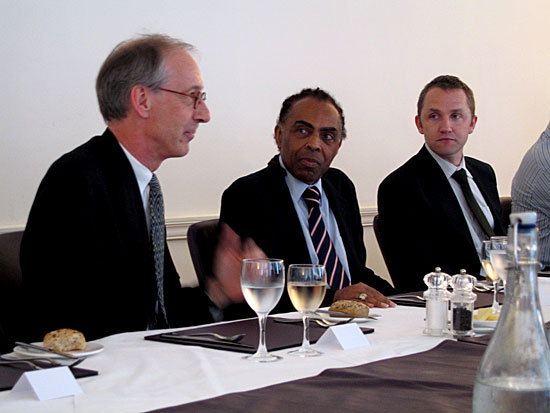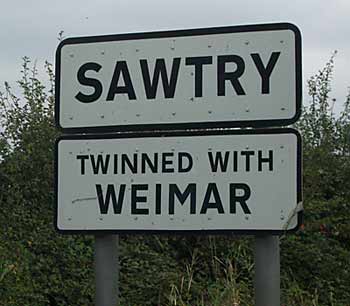If you’re a Mac user running OS X 10.4 (‘Tiger’), then this is something you simply must have.
Google Adsense
As an experiment, I’ve signed up with the Google Adsense system. Under this scheme, Google monitors the content of the Blog and places relevant ads in the sidebar. (You can see them if you scroll down a bit.) If a reader clicks on one of these paid-for links, Google pays me a small sum. (If I click on one of the ads myself, Google kicks me out of the system btw. Hmmm… I wonder what happens if I go to Memex from a public workstation and click on the ads from there?)
But I digress… I’ve signed up not in the hope of getting rich, but to explore the hypothesis that Adsense could provide a revenue model for supporting Blogging. The idea is that if you have a popular blog which attracts lots of readers, then you might be able to earn enough from Google to at least pay your web-hosting bills.
Well, maybe you could. But the more interesting question is whether signing up to Adsense would undermine the credibility — or integrity — of your blog. And already I’ve made an intriguing discovery. The first item I posted after signing up was the report below about the launch of the Adelphi Charter — which is all to do with reversing the commercial world’s current mania for stronger IP rights. And guess what the first two ads placed by Google were? One for an outfit called “The UK Copyright Service” (motto: “protect your work internationally — fast and secure registration service”); the other an ad for a trademark registration service!
I will persist with this for a few weeks to see how it goes, but the omens are not promising.
The Adelphi Charter

One of the projects I’ve been working on for a while came to fruition last night with the launch of the Adelphi Charter. Or, to give it its full name, the Adelphi Charter on Creativity, Innovation and Intellectual Property. It’s an attempt for formulate a sane set of principles to guide law-making on IP in a digital age, and the project was hosted and sponsored by the Royal Society of Arts, which has a 200-year record of concern about intellectual property issues. I was a member of the international Commission which drafted the document.

The Charter was launched at a crowded event at the RSA, during which two of my fellow Commission members, James Boyle (on the left) and John Sulston, gave memorable speeches.
John led the team which decoded the human genome in order to ensure that it remained in the public domain, and in the process put the whole of humanity in his debt (a debt only partly repaid by his being awarded the 2002 Nobel Prize for medicine). At one point in his talk, he invited us to contemplate what would have happened if he’d failed — if the genome (which, after all, is “the book of life”) had been copyrighted by a commercial company. Anyone who wanted to read the book would, firstly, have had to pay a fee, and secondly (and more importantly) would not be able to reveal what they’d discovered as a result of reading it. It would, he said be “like reading a book review and going to a bookshop to buy a copy and being told by the bookseller ‘No — you can’t see it'”.
In his opening declaration, John Howkins, who chaired the Commission, reminded people that the publication of the Charter was, in a way, only the end of the beginning. The real work lies ahead — in persuading governments and the public that we have to think again about the way we grant and regulate intellectual property rights.
Being a member of the Commission has been an exhilarating experience because it brought me into contact with such a range of formidable people — ranging from thinkers like James Boyle, John Sulston, Larry Lessig and Jamie Love, to activists like Cory Doctorow and artists like Gilberto Gil, the remarkable musician who is also Brazil’s Minister of Culture.

Gilberto could not be present at the launch (he was in Paris on government business), but on Tuesday he came to the RSA for lunch — as did James Purnell, the UK ‘Minister for the Creative Industries’ (shown here on the right of the picture. John Howkins is on the left.)
Media reaction:
X marks the spot

The sky over my house last evening.
The battle for control
Forceful piece in today’s International Herald Tribune by Carl Biltd, former Prime Minister of Sweden. Sample:
Beyond the headlines, a critically important battle for control of the Internet is being played out.
On the one side is the United States, which wants to retain supervision of the Internet and has managed to get the reluctant support of most of the global Internet community, which sees America as the least bad of the possible ultimate guardians of the system.
On the other side is a collection of states keen on getting as much as control as possible in order to curtail the Internet’s power to undermine their regimes. With the theocracy of Iran as the standard-bearer, this group brings together Saudi Arabia, China, Cuba and Venezuela. North Korea is probably keen to join in as well.
The European Union seems to be in the middle, wavering back and forth – and in its wavering it has recently come down with a position that has brought it enthusiastic applause from Tehran, Beijing and Havana.
Bildt thinks that the European Commission doesn’t know what it’s doing here, and I agree with him. In the end, the Americans will block this, and, for once, we may have reason to be grateful for their obduracy.
Thanks to Gerard for the link.
Hedgehogs and foxes
Freeman Dyson, writing about Richard Feynman in the current issue of the New York Review of Books opens with this paragraph:
Great scientists come in two varieties, which Isiah Berlin, quoting the seventh-century-BC poet Archilochus, called hedgehogs and foxes. Foxes know many tricks, hedgehogs only one. Hedgehogs are interested only in a few problems which they consider fundamental, and stick with the same problems for years or decades. Most of the great discoveries are made by hedgehogs, most of the little discoveries by foxes. Science needs both hedgehogs and foxes for its healthy growth, hedgehogs to dig deep into the nature of things, foxes to explore the complicated details of our marvelous universe. Albert Einstein was a hedgehog; Richard Feynman was a fox.
Well, I’m not a scientist, but I’m definitely a fox.
Signs of the Google times
Email from Pete…
Just typed in ‘to be or not to be’ in the Google search box, looking for the Hamlet speech – and guess what the first entry to appear is? Hot or Not?. Imagining some poor sod, on the verge of suicide, deciding to take counsel from the great Bard, and instead confronted with one of the outposts of 21st century voyeurism and vanity…Ye gods.
Settled!
Why home printing is a racket
From today’s New York Times…
It does not take an advanced business degree for those consumers to see how printer manufacturers like Hewlett-Packard and Canon make their money. They use the “razor blade” business model. It is named from the marketing innovation of King C. Gillette, who in the early years of the last century sold razors for a low price but made all his money on the high-margin disposable razor blades. Printer manufacturers also use this tied-product strategy.
Printers return relatively low profit margins. But the ink, ounce for ounce, is four times the cost of Krug Clos du Mesnil Champagne, which sells for around $425 a bottle. Ink is about the same price as Joy perfume, considered to be one of the more pricey fragrances, at $158 for a 2.5-ounce bottle.
Kodak’s bid to own your pictures
You couldn’t make this up. But I’ll let Dan Bricklin (a keen digital photographer) tell the story…
The idea of a “Wi-Fi” camera seems exciting but in trying to understand it I found that it comes with a big boat anchor — the photos are uploaded to Kodak’s site. But you don’t really own the pictures. If you ask they will sell your photos to you and deliver them to you on a CD (no downloads!) which contains your entire collection of pictures! According to their site you can’t even specify which photos — you have to pay according to how many photos are in your account!
Since the site and rules may change there’s what KodakGallery (formerly Ofoto) currently says: “When you order an Archive CD, your entire photo collection will be preserved on CD. Photos are saved as full-sized JPEGs in their original resolution. Archive CDs are priced according to the total number of photos in your account.”
While the idea of having your photos automatically moved from your camera to the Internet sounds wonderful, you lose ownership of your own pictures. Or maybe you shouldn’t think of them as yours — they effectively belong to Kodak and you get only controlled access. As much as Kodak seems to want to leave their silver-halide heritage behind they seem to be stuck in the old business model of making money when you process the picture, when you print the picture and whenever you want to print it again. It’s another example of how hard it is for a company to change its basic nature.
This is part of the larger trend that is fighting to keep control. The record industry doesn’t want to let you have any control over the bits you buy and Tellywood wants to wrap everything in a very tight DRM straightjacket. These are a business premised on control and they seem unable to change their basic nature. For them it makes a lot of sense to fight the future as long as they can. They have no better option and if they are smart they are taking cash out so when their business evaporates they can retire.


